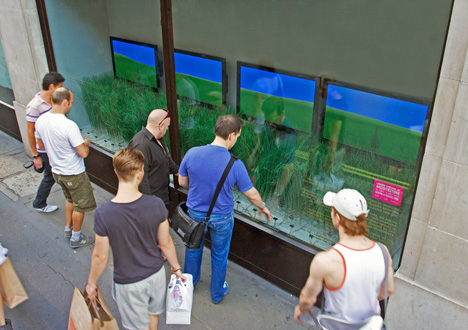The Grass Is Always Greener: "Urban Prairie" by In Square Lab

London's In Square Lab, an architectural practice that specializes in "Time-Based Architecture," recently collaborated with MPC Digital and Existential on "Urban Prairie," an interactive window installation in the heart of their hometown. The 5m window display consists of a row of optical sensors facing the street, which are programmed to translate the motion of passersby into a simulated breeze, embodied in the movement of grasses.

Of course, the installation is but a meter deep: hence, the flatscreens—which are also in sync with the cameras—that represent a virtual sea of prairie.

It makes more sense in action:
In this project, the main challenge for the team was to create a system that allows for maintaining or even extending the notion of green spaces through intelligent use of design and technology via 4th dimension (time + space) design [and] to inspire and provoke discussions and speculations about the concept of inside vs outside, here vs there and virtual vs realism.
Using an array of optical sensors and arduino boards, urban prairie captures and comprehends the movements of passersby in front of the installation. This digital data is then translated into kinetic responses via a series of servos; creating the phenomenon of a sea of grass swaying in the breeze. The motion of the 'real' grass is in turn measured by the specially designed software and translated to a field of virtual prairie on screens behind the 'real' grass. The combined result is an 'Urban Prairie' which passersby can engage and interact with through their movements in space. By varying their speed and location in front of the windows, passersby can generate wind disturbance that travels from the 'real' grass to the virtual prairie seamlessly and eventually fading off into the horizon.

"Time-Based Architecture" is an emerging field that is concerned with intelligent interactions between an environment and its users. This practice follows from advances in technology and new media, which enable real-time engagement.

I personally feel that the physical "grass" in the foreground is rather more successful than the digital displays, though it may just be an unavoidable shortcoming of the photo/video documentation... perhaps it would be more immersive if the background was projected onto the entire back wall? In any case, I'd be curious to see this project executed on a larger scale in, say, New York's High Line.

If "Urban Prairie" and "Be Your Own Souvenir" are any indication, we're definitely seeing some clever (if not quite perfect) applications of new media in the real world. Between increasing availability (i.e. the Kinect) of hardware and creative software programming, I can't imagine what is on the horizon—real or virtual—for interaction design.
-
oFavorite This
-
QComment
K
{Welcome
Create a Core77 Account
Already have an account? Sign In
By creating a Core77 account you confirm that you accept the Terms of Use
K
Reset Password
Please enter your email and we will send an email to reset your password.

